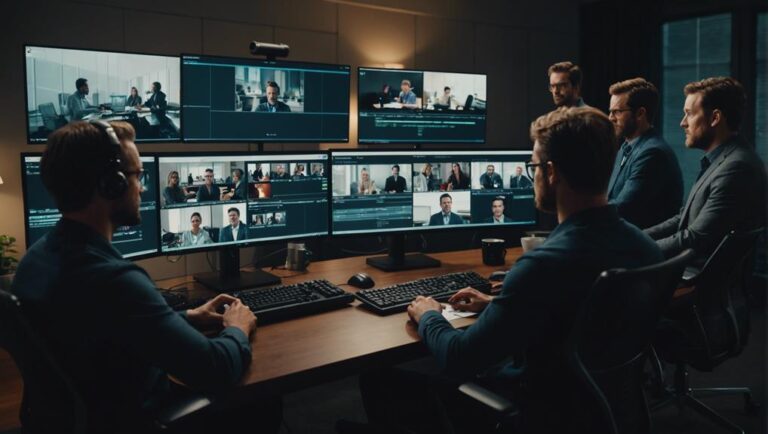Strategies for Avoiding Miscommunications in Remote Teams
To avoid miscommunications in your remote team, establish clear channels like Slack for instant communication. Set expectations, define protocols, and clarify response times. Regularly check in with team members for feedback. Use project management tools to monitor progress and roles. Hold daily stand-ups and virtual coffee chats. Provide constructive feedback and foster a culture of transparency. By embracing these strategies, you can enhance communication and teamwork for better productivity.
Establishing Clear Communication Channels
To prevent misunderstandings, establish clear communication channels within your remote team to guarantee effective communication. Team collaboration is essential in remote work settings, and having transparent communication channels is key to fostering a cohesive team environment.
Utilize tools like Slack, Microsoft Teams, or Zoom to facilitate real-time communication and collaboration among team members. Encourage open dialogue and active participation in virtual meetings to make sure that everyone feels heard and understood.
Effective communication involves not only sharing information but also actively listening to others. Create guidelines for communication within your team, such as setting expectations for response times and establishing preferred communication methods for different scenarios.
Regularly check in with team members to see how they're adapting to remote work and if they've any communication preferences or concerns.
Setting Expectations and Guidelines
Establish clear expectations and guidelines for communication within your remote team to guarantee smooth and efficient collaboration. When it comes to team engagement in remote settings, it's important to establish clear communication protocols. Define the preferred methods of remote communication, whether it's through emails, instant messaging, or video calls.
Setting guidelines for virtual meetings is essential to make sure everyone participates actively and stays engaged. Clearly outline meeting agendas, assign roles to team members, and encourage active participation to enhance team collaboration.
Remote communication can sometimes lead to misunderstandings due to the lack of face-to-face interactions. By setting expectations for how and when team members should communicate, you can minimize the chances of misinterpretations. Establish guidelines for response times to emails or messages, clarify the use of emojis or tone indicators in written communication, and encourage open dialogue within the team.
Encouraging Regular Check-Ins
Clear and consistent communication is key in remote teams, and one effective way to guarantee alignment and collaboration is by encouraging regular check-ins. Daily stand-ups provide a structured opportunity for team members to discuss their tasks, priorities, and any challenges they might be facing. These brief meetings foster transparency and keep everyone on the same page.
In addition to daily stand-ups, weekly progress reports can offer a more thorough overview of each team member's accomplishments and goals for the upcoming week. This helps in tracking progress and identifying any potential roadblocks early on.
To further strengthen team bonds and maintain a sense of camaraderie, virtual coffee chats can be scheduled for informal conversations. These casual interactions can boost morale and create a more connected remote team environment.
Lastly, organizing team huddles where all members come together for a more extended discussion can facilitate brainstorming sessions, problem-solving, and decision-making processes. Regular check-ins in various forms are essential for enhancing communication, teamwork, and productivity in remote teams.
Utilizing Project Management Tools
Effective utilization of project management tools is essential for maximizing efficiency and productivity in remote teams. Task tracking features within these tools allow team members to monitor individual assignments, deadlines, and progress.
By utilizing task tracking, you can verify that everyone is on the same page regarding project milestones and responsibilities.
Collaboration tools play a vital role in enhancing communication and teamwork within remote teams. Features like real-time messaging, file sharing, and video conferencing facilitate seamless interaction among team members regardless of their physical locations.
These tools enable quick decision-making, brainstorming sessions, and the sharing of valuable insights, fostering a cohesive working environment.
When selecting project management tools for your remote team, prioritize platforms that offer both task tracking and robust collaboration capabilities.
Clarifying Roles and Responsibilities
When working in remote teams, it's essential to have clear role definitions to avoid confusion.
Make sure to provide regular updates on tasks to stay aligned with your team.
Keep communication channels open for any questions or clarifications that may arise.
Clear Role Definition
How can you guarantee that every team member comprehends their roles and responsibilities clearly in a remote setting?
To secure clear role definition, start by establishing effective communication channels for role delegation. Clearly outline each team member's responsibilities and tasks to avoid confusion. Encourage open dialogue for any questions or clarifications to be addressed promptly. Utilize task allocation tools to assign duties transparently and track progress collaboratively.
Foster team collaboration by emphasizing the importance of understanding each other's roles within the team dynamic. Regularly review and adjust roles as needed to adapt to changing circumstances or project requirements. By maintaining a structured approach to role definition, incorporating feedback, and promoting a culture of shared responsibility, you can enhance team cohesion and productivity in a remote work environment.
Regular Task Updates
To guarantee that team members understand their roles and responsibilities clearly in a remote setting, it's important to provide regular updates on tasks to clarify and reinforce their understanding of their duties. Daily updates and status reports play a vital role in keeping everyone on the same page. These brief summaries of progress help team members track developments and make certain that work aligns with overall objectives.
In addition to daily updates, scheduling regular team meetings is essential for discussing progress reports collectively. During these meetings, team members can share updates, address any challenges, and realign priorities if needed. These interactions foster a sense of unity and shared responsibility, enhancing collaboration within the team.
Open Communication Channels
Maintaining open communication channels is essential for clarifying roles and responsibilities within remote teams. In remote settings, it's important to establish regular check-ins and clear channels for team members to discuss their roles and responsibilities.
Setting up virtual activities can help foster team bonding and create opportunities for informal social interactions among remote team members. Encouraging open communication about tasks and project expectations can prevent misunderstandings and guarantee everyone is on the same page regarding their responsibilities.
To enhance team collaboration and understanding of each other's roles, consider organizing virtual team-building activities. These activities can range from online games to virtual coffee breaks, providing space for team members to interact on a more personal level.
Embracing Video Conferencing
Utilize video conferencing as a primary communication tool to enhance collaboration and reduce misunderstandings in remote teams. Video conferencing bridges the gap created by physical separation, allowing for face-to-face interactions that can greatly improve engagement and enhance collaboration among team members.
Seeing facial expressions, gestures, and body language adds depth to conversations, aiding in better understanding and fostering stronger connections.
By incorporating video conferencing into your remote team's communication strategy, you can create a more interactive and dynamic environment where ideas flow more freely, and discussions are enriched. This real-time interaction helps to build trust and camaraderie, essential elements for effective teamwork.
Furthermore, video conferencing can prevent miscommunications that often occur in text-based communication by providing visual cues and immediate clarification opportunities. It ensures that messages are received as intended, reducing the chances of misunderstandings that can hinder productivity and teamwork in remote settings.
Providing Constructive Feedback
Enhance team performance by offering constructive feedback that focuses on specific behaviors and outcomes. When providing feedback in remote teams, remember to follow feedback etiquette to guarantee a positive and productive exchange.
Begin by highlighting the specific actions or results that warrant discussion, rather than making general statements. Remote training can also help team members understand how to give and receive constructive criticism effectively, fostering a culture of continuous improvement.
Constructive feedback plays a significant role in team building by fostering open communication and driving individual and collective growth. Be specific about what behaviors or outcomes need improvement and offer actionable suggestions for how to achieve this.
Remote teams can benefit greatly from feedback that's clear, respectful, and focused on solutions rather than blame.
Cultivating a Culture of Transparency
To cultivate a culture of transparency within your remote team, encourage open and honest communication channels for sharing feedback and information. Building trust is vital in remote work settings, and fostering honesty among team members is essential to achieving this. Encourage a safe space where team members feel comfortable expressing their thoughts, concerns, and ideas without fear of judgment.
Promote transparency by setting clear expectations regarding communication norms and guidelines. Emphasize the importance of timely and open communication to avoid misunderstandings and promote a culture of trust within the team. Regularly scheduled check-ins and team meetings can provide opportunities for team members to share updates, ask questions, and address any issues that may arise.
Encourage active listening among team members to ensure that everyone feels heard and understood. Acknowledge and address any concerns or conflicts promptly to maintain transparency and trust within the team.
Conclusion
In the fast-paced world of remote teams, communication is the glue that holds everything together. By establishing clear channels, setting guidelines, and embracing regular check-ins, you can steer your team towards success.
Remember, communication is like a well-oiled machine – when all parts are working together smoothly, the results speak for themselves. So keep those lines of communication open and watch your team thrive.







